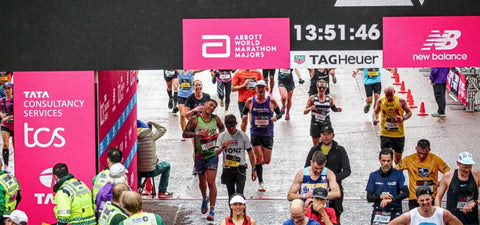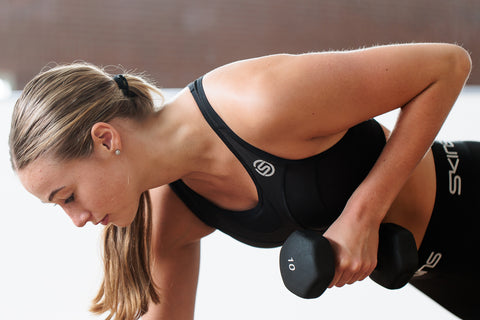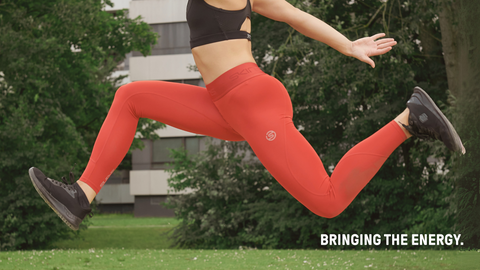HOW SKINS HELPED STELLA AND MAX MANAGE THEIR EDS AND POTS SYMPTOMS
As a young child, Stella was always active and eager to try everything! Gymnastics, dance, soccer, softball, ice skating, and swimming were just some of the activities in which Stella participated. Even at this young age, Stella’s mom, Donna, recognized that Stella’s movements seemed a bit “floppy.”
Donna and her husband, Todd, who is a general surgeon, had known for years there was a serious issue, but because it’s nearly impossible to get diagnosed, it wasn’t until Stella was 14 years old that they received the official diagnosis of Ehlers-Danlos Syndrome (EDS). EDS is a genetic collagen and connective tissue disorder that primarily affects skin, joints, and blood vessels. Donna describes it this way. “Your connective tissue is the glue that holds your body together. Stella’s glue is a little thin and all the connective tissue is very stretchy.”
Stella has the most common type of EDS called “Hypermobile EDS.” This is where a person has overly flexible joints that can move far past the normal range of motion. It can cause muscle fatigue, chronic pain, premature arthritis, and dislocations. The severity of these symptoms varies for each individual.
For a time, Stella was practically bedridden because the joint pain and fatigue was so severe.
Since connective tissue runs throughout the body, other medical conditions related to EDS will often appear. One such condition is a blood circulation disorder called Postural Orthostatic Tachycardia Syndrome (POTS). In POTS, the nerves that regulate blood flow are out of balance, so not enough blood returns to the heart. This results in an overly rapid heartbeat when a person stands up after lying or sitting down.
Normally, the heart will increase 10 to 15 beats per minute after standing. For people with POTS, the heart increases by 30 to 50 beats per minute resulting in dizziness, nausea, headaches, brain fog, and even fainting.
Like EDS, it is difficult to get a POTS diagnosis. POTS symptoms often mimic the symptoms of anxiety, so it is often under and misdiagnosed. One Christmas, Stella was given an Apple Watch and began to take note of any heart rate changes. Just by walking around the house, Stella’s heart rate climbed into the 160 to 170 range. This helped validate their suspicion of POTS. Stella, now 20, was given the official diagnosis at 18 years old.
About this time, Stella’s younger brother Max, was also diagnosed with POTS. He has recently been diagnosed with EDS as well. Like Stella, Max participated in sports when he was younger, but has now found his passion as a vocal performer in musical theater.
There is no cure for either syndrome at this time, but countermeasures may be taken to help manage the symptoms. For example, increasing fluids, salt intake, and electrolytes will help to circulate blood and get it back to the heart. Limiting exposure to hot and humid weather is beneficial. In some cases, taking certain medications like beta blockers may be used to reduce the heart rate.
In addition, compression garments should be worn to help push blood into the deeper veins to aid in circulation. This helps prevent blood pooling and is especially important when standing for long periods of time. For people with EDS, selecting proper fitting compression garments is more than just a comfortability issue. Weakened connective tissue allows the skin to stretch much more than usual causing it to be fragile.
Stella and Max have worn compressions garments for quite some time and have tried lots of brands. They have found that some compression garments were too tight and dug into the back of their legs or waist, irritating their fragile skin. Other garments were too loose and did nothing to help with circulation.
When they tried the SKINS tights, they found they were not only comfortable, but they fit just right, did not irritate their skin, and targeted the exact areas that required more support.
After first trying on the SKINS, Stella said, “Oh. This is what it feels like to have connective tissue that actually works!” Further, Donna said that while wearing SKINS, “Stella’s body finally felt like it was being held together.”
Both Stella and Max wear a variety of SKINS products and prefer the SKINS SERIES 5 as it provides the most compression. Stella’s favorite is the SKINS SERIES-5 WOMEN’S SKYSCRAPER TIGHTS. The high and wide waistband is very comfortable and does not dig into the waist. Max appreciates that he can wear the SERIES 5 - MEN’S LONG TIGHTS under shorts, pants, and theater costumes. They really help him when he is on his feet during long rehearsal days.
He is not only less fatigued, but the compression helps eliminate blood pooling in his feet and abdomen.
By sharing their story, Donna hopes to help raise awareness about EDS and POTS. Getting these diagnoses is difficult and time consuming, but her advice is to never stop advocating for your children. If you think your child may have EDS or POTS, seek out the right doctor. It may be weeks before you find or see the right doctor. In the meantime, you may be able to help your child feel better by increasing liquids and salt and also wearing compression garments.
While there are certainly challenging days, Stella and Max are beautiful examples of how to live a full, active life with EDS and POTS. Stella is a talented singer-songwriter, and is considering a career in meteorology. Currently, Stella enjoys volunteering as a makeup artist with community theatre groups. Max is a junior in high school who plans to attend college and is considering pursuing vocal performance, specifically in opera. That’s a lot of talent in one family!
We at SKINS have no doubt they will be successful in all their endeavors and wish them all the best!







